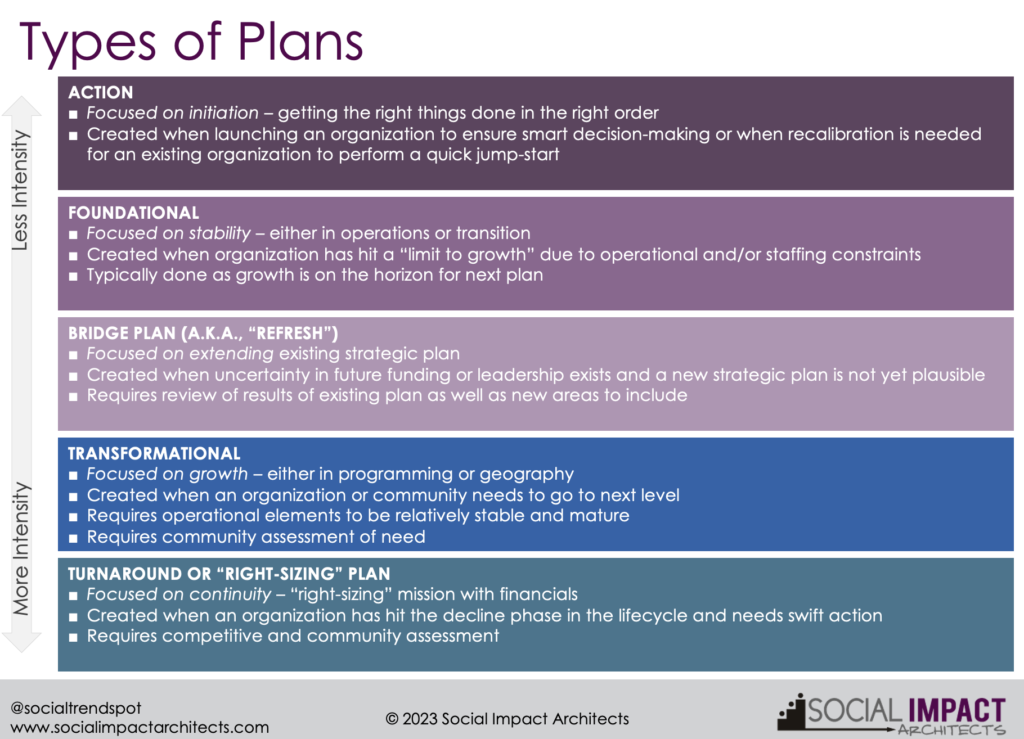 While there are numerous books and websites on strategic planning, the process of developing a plan can seem prescriptive. But it shouldn’t be that way. Strategy for any organization can be tailored to set forth the ways in which an organization will negotiate its environment to attain a competitive advantage. A strategic plan determines how the organization is going to undertake this strategy – at all levels of the organization in a sustainable fashion – over a pre-determined time period. However, strategic planning is not a “one-size-fits-all” process because all organizations are different – they are at different phases in the lifecycle, focused on different issue areas and experiencing outside influences more or less intensively.
While there are numerous books and websites on strategic planning, the process of developing a plan can seem prescriptive. But it shouldn’t be that way. Strategy for any organization can be tailored to set forth the ways in which an organization will negotiate its environment to attain a competitive advantage. A strategic plan determines how the organization is going to undertake this strategy – at all levels of the organization in a sustainable fashion – over a pre-determined time period. However, strategic planning is not a “one-size-fits-all” process because all organizations are different – they are at different phases in the lifecycle, focused on different issue areas and experiencing outside influences more or less intensively.
We have spoken a lot about how to best pursue a strategic plan. But something was still missing. We found that we needed different types of strategic plans in order to directly address our clients’ unique needs within their competitive environments. Our experience has shown us that determining which type (or types, since they can be blended) of strategic plan is needed for an organization is both art and science. As you move forward in your strategic planning efforts this summer, we encourage you to reference the information below to chart the best course for your organization:
Action Plan
- Focused on initiation – getting the right things done in the right order
- Created when launching an organization to ensure smart decision-making or when recalibration is needed for an existing organization to perform a quick jump-start
For start-up organizations or those that have operated without a strategic plan in the past, a quick one-year action plan can be very helpful for building the discipline around planning without dealing with a complicated and often costly process. We also use action plans as a tool to start new ventures or new objectives within an existing strategic plan.
Foundational Plan
- Focused on stability – either in operations or transition
- Created when an organization has hit a “limit to growth” due to operational and/or staffing constraints
- Typically done when growth is on the horizon for next plan
When business experts looked at Fortune 500 companies that have been around for a century or more, they noted that these companies cycle back and forth successfully between two phases – growth (see transformational below) and plateau. Plateauing doesn’t mean the organization isn’t growing, but it does mean that it is focused on building up foundational infrastructure and correcting “growing pains” before it hits another phase of growth. Organizations need this downbeat to take stock and ensure that operational areas are functioning at their maximum levels of efficiency based on best practices.
Bridge Plan (also known as a “Refresh”)
- Focused on extending existing strategic plan
- Created when uncertainty in future funding or leadership exists and a new strategic plan is not yet plausible
- Requires review of results of existing plan as well as new areas to include
Many of our clients who had been planning to start a strategic planning process in 2020 course-corrected once the pandemic hit and decided to use a shorter-term “bridge plan.” Because of the many unknowns and the extra work associated with meeting community needs during the pandemic, a bridge plan was the perfect way to focus on strategic issues without overtaxing the organization or making unrealistic plans. Now, our clients are revisiting their past plans (pre-2020), and we are busy with a “refresh” to revisit pre-pandemic goals and bring them up to date to meet current needs. It is a quicker way to dust off the old plan, take stock of any changes needed during or related to the pandemic or downturn, and have a fresh plan for 2023.
Transformational Plan – Growth or Evolutionary
- Focused on growth – either in programming or geography
- Created when an organization or community needs to go to the next level
- Requires operational elements to be relatively stable and mature
- Requires community assessment of need
For many years, a strategic plan was synonymous with a transformational strategic plan. However, we have found in our practice that growth, especially in the traditional for-profit sense of “growing bigger,” isn’t always the right answer in the nonprofit space. Nonprofits have two types of growth: 1) growing wide (larger geography, more programs) or 2) growing deep (getting better at what you are already doing). Both have merit but require different litmus tests. A transformational strategic plan asks why the problem exists and, more importantly, persists, and what your organization can uniquely do to solve it. We have also found that there are two kinds of transformational plans: 1) growth transformational planning, which forecasts trends and charts the best course forward for growth of the organization, and 2) evolutionary transformational planning, which sets the trend and often redefines an industry and the organization’s competitive advantage within the community. To put this into more concrete terms, growth planning is about taking a larger piece of the pie and evolutionary planning is about growing the pie (or changing the recipe).
Turnaround or “Right-Sizing” Plan
- Focused on continuity – “right-sizing” mission with financials
- Created when an organization has hit the decline phase in the organizational lifecycle and needs swift action
- Requires competitive and community assessment
While the name alone makes it hard to talk about, many nonprofits right now need to consider a turnaround plan – not necessarily due to poor management, but due to the external forces of the pandemic and the economic downturn. Instead of “turnaround,” we often use the word “right-sizing” to describe this plan. Due to the financial challenges of the pandemic, many nonprofits need to retrench, consolidate and experience a rebirth. Sometimes the resulting organization can be leaner and better able to tackle issues more creatively.
While we often look at these types of plans separately, they can often be blended together or used to define a given year. For example, we are working with a large nonprofit now on strategic planning where they are “right-sizing” their mission in certain areas but are taking a more transformational growth approach in others. Another nonprofit did a bridge plan for 2022-2023 and has been using “bridge” as a theme for the year. We hope you have enjoyed this breakdown of different strategic planning types. We would love to hear your reactions to them.

